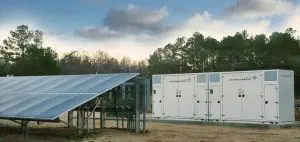As organizations move toward net-zero carbon initiatives, microgrids have become a driving force in the overall sustainability trajectory because of their expansive application across industries. Jana Gerber, microgrid North America president at Schneider Electric, explains.
by Jana Gerber
 The need for advanced electrical storage and distributed energy resources to supplement the expansion of an industry’s energy and productive output, especially from renewable resources, has seen rapid growth in recent years. In fact, demand for electricity is set to triple by 2050, with renewable generation responsible for 80%-90% of that electricity. In order to facilitate the anticipated demand for this transition in energy distribution and generation, advanced cloud-driven and centralized controls in an integrated microgrid are necessary for progress.
The need for advanced electrical storage and distributed energy resources to supplement the expansion of an industry’s energy and productive output, especially from renewable resources, has seen rapid growth in recent years. In fact, demand for electricity is set to triple by 2050, with renewable generation responsible for 80%-90% of that electricity. In order to facilitate the anticipated demand for this transition in energy distribution and generation, advanced cloud-driven and centralized controls in an integrated microgrid are necessary for progress.
A microgrid is a self-contained electrical network that allows organizations to generate their own electricity on-site. Microgrids tie together distributed energy resources in their system and can operate while connected to the utility grid or in disconnected “island” mode, utilizing software controls and battery energy storage system technology to effectively distribute and regulate energy resources when and where they are needed most. Though this technology might sound advanced and intimidating, microgrids are incredibly accessible and can provide the electrical infrastructure to power many different industries and everyday power needs such as commercial real estate, residential communities, government facilities, schools, bus depots and much more.
Microgrids in the real world — how it all works
Facilities often look for sustainability, and microgrids meet this need while also providing resilient and reliable power sources. Widespread microgrid adoption has led to this technology emerging as a main component in energy distribution strategies for organizations looking to improve both sustainability and operational resilience while also managing costs and efficiencies.
Microgrids are incredibly versatile — and their application enhances the operation of any facility that benefits from stronger electrical controls and integrated energy management. Below are some real-world examples that illustrate how microgrids impact nearly every facet of our everyday lives through digital and energy management transformation.
Leave a Reply